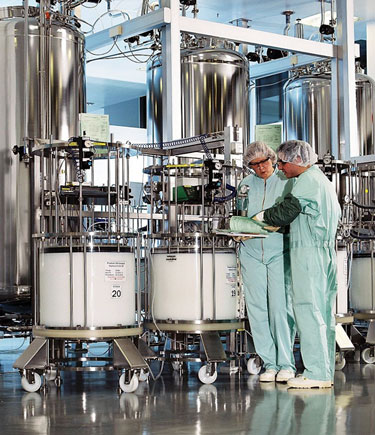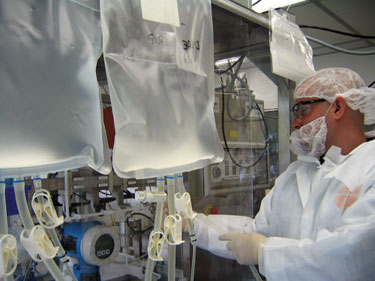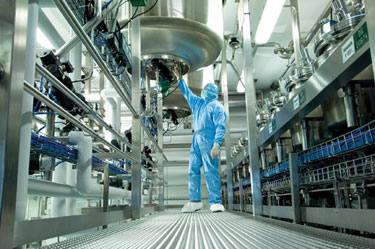October 1, 2009 (Vol. 29, No. 17)
Cindy Liu
William Downey
Firms Constantly Improving Operations with Enabling Technologies and Cost-Cutting Measures
The biopharmaceutical contract manufacturing (CMO) industry has experienced a significant improvement in the average expression levels for both mammalian cell culture and microbial fermentation, according to the “Biopharmaceutical Contract Manufacturing 2009: Expanding Markets, New Capacities and Improved Performance” report recently published by HighTech Business Decisions.
The industry study with directors from 29 biopharmaceutical CMOs and 48 pharmaceutical and biotechnology companies showed that expression yield has improved significantly over the last two years. Firms attribute much of the increase to use of high-expression systems and continuous process improvement.
Improvements in efficiency and increased productivity resulting from new technologies have helped CMOs gain new customers. For example, Oxford-Emergent Tuberculosis Consortium, a joint venture between the University of Oxford and Emergent BioSolutions, signed a commercial license agreement in May with ProBioGen to explore production of the MVA85A TB vaccine using ProBioGen’s AGE1.CR.pIX® cell line.
Companies cite improvements in media, overall process, and cell-line development as examples of methods that will further improve yields. However, increased titers and improved expression yields have created pressure on downstream processing. In addition to capacity concerns, the downstream processing bottleneck is consistently cited by pharmaceutical and biotechnology companies as one of the top three biomanufacturing challenges.
Many CMOs are addressing the downstream processing bottleneck by implementing membrane chromatography, high-performance liquid chromatography (HPLC), protein crystallization for protein purification, wider adoption of disposables, and use of process analytical tools (PAT).

Boehringer Ingelheim, which is continuously expanding its protein purification toolbox, is increasing its use of crystallization to reduce chromatography steps.
Reducing Need for Chromatography
NPro Autoprotease Fusion Technology (NAFT) is a new technology being implemented by Sandoz Biopharmaceuticals. According to Friedrich Nachtmann, Ph.D., head biotech cooperations, “NAFT is a novel expression system yielding inclusion bodies of a fusion protein that consists of an autoprotease portion and the target protein or peptide. The autoprotease part cleaves off after renaturation, providing high yield of correctly processed target protein or peptide.”
Rentschler Biotechnologie is working on research projects dealing with protein crystallization for industrial protein purification. Professor Roland Wagner, svp of development, said that “crystallization of proteins is commonly used for determination of the 3-D structure of proteins. However, proteins in crystalline state are of high purity and usually more stable than dissolved ones. Therefore, the method is expected to be beneficial for the rapid purification and stabilization of pharmaceutical proteins.”
Also increasing its use of crystallization is Boehringer Ingelheim, which is continuously expanding its protein purification toolbox. Vitomir Vucenovic, Ph.D., senior manager of enabling technologies, the corporate division biopharmaceuticals, explained, “depending on a protein’s nature, we are able to crystallize, wash, and resolve the protein again, thereby reducing chromatography steps and overall time.”
Quality by Design
One of the challenges for downstream processing is reducing development time and also delivering robust processes and qualitative product. To overcome these challenges Boehringer Ingelheim is using platform technologies and adapting those to each product’s needs. How novel manufacturing technologies fit into the platforms or even create a platform itself are evaluated continuously.
For example, RAPPTor™, a miniaturized and automated platform for screening of resins and conditions, has been implemented to reduce material and labor costs during process development. With RAPPTor, 64 conditions in triplicate, which means a total of 192 experiments, can be screened in three days, the company reported.
Bioprocessing efficiencies have also been introduced. “High-titer processes require higher buffer volumes, which became a bottleneck in downstream processing,” Dr. Vucenovic noted. “The implementation of in-line buffer dilution into the process reduced the required tank volumes and, thus, footprint.”
Other CMOs also noted the use of new resin technologies. Eden Biodesign has introduced CIM® monolith resin technology (BIA Separations) for both chromatographic separation and HPLC analysis of adenoviral products. According to Roger Lias, Ph.D., president of Eden Biodesign, “the technology has increased both the resolution of separation and the speed of operation.”
At Sandoz, PAT initiatives include online HPLC for immediate intermediate quality control, as well as multivariant data analysis to predict quality-related parameters based on a given set of input parameters, and as a tool to optimize and stabilize the yield of process steps. According to Dr. Nachtmann, “applying such methods in one of our lead products resulted in a productivity increase of approximately 30 percent.”

Laureate Pharma has incorporated disposables into its standard platform process for downstream antibody purification.
Adoption of Disposables
Most CMOs manufacture multiple products, so the ability to increase flexibility and reduce the time line is a key competitive advantage. “The use of disposables are of great benefit to a multiproduct facility where we have to deal with tight manufacturing scheduling coupled with rapid operational turnaround between contracts and batches,” Daniel Smith, commercial scientific development manager at Cobra Biomanufacturing, explained.
“Disposables enable a reduction in time taken to clean, prepare, and reclean operational hardware allowing the ensuing reduction in cost to be passed directly on to our customers,” he added. Cobra has developed a new process based on the use of sterile disposable technologies at all stages of manufacturing, including a closed-system tangential flow filtration (TFF) step for buffer exchange and a manifold design for product storage and sampling.
Besides speeding up turnaround time between unit operations, the use of disposables also reduces water for injection (WFI) for cleaning. According to Michiel E. Ultee, Ph.D., vice president of process sciences at Laureate Pharma, “Studies have shown that between 50 to 70 percent of WFI goes toward cleaning operations. WFI has a high energy cost.”
Another key benefit of disposable technology adoption is to increase process safety, a fact confirmed by Rene Brecht, Ph.D., vp of process science and manufacturing at ProBioGen, who added that “the risk of cross-contamination in a multiproduct facility is reduced by use of single-use technologies.”
In addition to full disposable upstream equipment, ProBioGen has implemented membrane chromatography, a set of single-use operations for liquid handling (bags, connectors, tubing, pump systems) and another set of single-use operations for filtration (depth filtration, sterile filtration) for downstream purposes. ProBioGen is also planning to establish single-use TFF technology.
Business Impact
The use of these innovative technologies has increased overall process efficiency, productivity, and process robustness. As disposables become widely used in the industry, many CMOs have commented that disposables enable a reduction in GMP-suite turnaround time due to elimination of cleaning requirements, which allows reduction in cost to be passed directly to their customers. The reduced project time line provides flexibility and agility, and CMOs are able to acquire more projects and provide more services.
“For bioreactors, the initial investment cost with disposable systems is substantially lower compared to conventional bioreactors,” explained Prof. Wagner from Rentschler. “In terms of safety, disposable bioreactors greatly reduce the risk of cross-contamination, which is crucial for special applications like cell therapy with human cells for the treatment of cancer and immune system diseases, and production of recombinant biopharmaceutical proteins and vaccines.”
Similar sentiment was echoed by Philip Ridley-Smith, business development and group marketing manager at Cobra, who said, “the design and building of new facilities will benefit from the use of disposable technologies in order to reduce time and cost and provide greater flexibility to the type and range of products that can be manufactured in a single space.
“As more disposable suppliers enter the market and demand increases there should be a decrease in the cost of goods that will reduce the overall production costs. CMOs, and the industry in general, are seeing an increasing trend for the R&D and production of biosimilar products. With these types of products the pressure to reduce the cost of goods is significant and disposable technologies can provide one of the solutions to producing a competitive biosimilar product,” Ridley-Smith concluded.
“Disposables will play an essential role in small-scale GMP environments and in some multiproduct facilities,” Dr. Vucenovic from Boehringer added. “However, stainless steel bioreactors will remain the preferred option for large-volume products.”
According to Dr. Nachtmann from Sandoz, “disposable systems are clearly advantageous for small-scale low-throughput manufacturing enabling high flexibility with lower investment cost. High-throughput development or high-throughput manufacturing at large scale will keep the focus on automated CIP and SIP systems, which are extremely fast, provide reliable quality, and do not need operator interaction.”
However, Dr. Nachtmann also noted that “the setup of disposable systems not only raises general extractables levels, but also needs an installation qualification for each setup. Certainly, disposables can also be implemented in a conventional facility such as capsule filters and bags for transfer small amounts of product.”
While the adoption of disposables reduces cost, it also has an unintended consequence, which is that it lowers the barrier to entry. “The use of disposables is growing as it reduces GMP-suite turnaround times and can help to reduce the cost of goods for a biopharmaceutical product. This is useful for existing manufacturing organizations and their clients. However, what may be key to the CMO industry is that the growing use of disposables also reduces the barriers to entry into this market,” stated Joanne McCudden, Ph.D., director of marketing and sales at SynCo Bio Partners.
“One key barrier has traditionally been the facility set-up costs,” Dr. McCudden explained. “Being able to use disposables in both upstream and downstream production means that the initial capital costs can be reduced. In a competitive marketplace, this poses both a risk and an opportunity to CMOs—CMOs can expand more easily and with lower capital expenditure. However, medium-sized biotech companies, a key market segment to the majority of CMOs, will be able to set up their own facilities more easily too.”
Convenience is a big factor in using disposables in a multipurpose facility, but disposables require great care as noted by Hiroko Tsukamoto, director of marketing at ASPEX, at division of Asahi Glass. “To discard the disposables after use, they need to be cut up and the expenses increase as a result. Therefore, we evaluate the use of disposables on a case-by-case basis.”
Future Downstream Processing
Technologies that will increase overall process efficiency and enable fewer process steps to ultimately reduce cost and project timelines will have the largest impact on the industry. Many agree that the downstream-processing bottleneck will not be overcome by gradual improvement, but via disruptive innovation.
There are many new technologies being explored in the industry, but it is unclear which ones will stand out. “Candidates include optimization of aqueous two-phase systems/crystallization; adoption of alternative chromatographic separations (expanded bed, simulated moving bed, nonaffinity, nonprotein A ligands); and further integration of nonconventional continuous matrix supports (monoliths or membrane absorbers),” Dr. Lias from Eden Biodesign said.
Over the past two years, Cobra has been performing feasibility programs for the integration of disposable technologies into existing in-house platform processes, the cGMP facility, and the quality systems, so that it is ready to meet the ever increasing needs of its customers.
“The introduction of completely disposable flow paths fitted to operational control hardware (i.e., bioreactors, pumping systems, filtration, and chromatography systems) will reduce the requirement for cleaning and validation activities and should, as such, confer an increased safety assurance level to the industry,” Smith said.
“The implementation of new technologies in manufacturing is mainly driven by economic aspects,” according to Dr. Brecht. “Therefore, relevant technologies that make processes more efficient and/or reduce process steps will be implemented in manufacturing, for instance, mixed-mode resins, high-capacity materials for purification, and disposables.”
It is essential that these new technologies have been established in process development, Dr. Brecht noted. “All manufacturing operations have to be established already during process development and be scaled up for production. We are addressing this challenge by having a tight cooperation between our process-development and manufacturing team.”
Disposable membranes may play an increasing role in purification. Laureate Pharma has already made disposable membrane filters for flow-through steps such as ion-exchange, part of its standard process for downstream antibody purification.
“The use of disposable membrane filters avoids the need to pack and qualify columns, speeding turn-around time. The flow properties of the membranes also allow faster processing than columns,” said Dr. Ultee.
“These large disposable membrane columns increase speed, as well as flow rate,” Prof. Wagner added. “To improve downstream performance, many manufacturers are increasingly focusing on improvements to reliability and consistency of their production.
“Many of these changes will be initiated in the process-development area rather than in commercial production. There are a number of Protein A column alternatives in development that promise to perform better, use higher pH, are more durable and cleanable, yet have similar efficiency and better binding capacity. These factors will be critical in the future.”
Financial Market Impact
Despite the economic slowdown, a few CMOs pointed out that their business has increased. “Demand appears to remain robust,” Eden’s Dr. Lias said, “and it can be argued that we are seeing increased interest from multinational pharma and biotech companies as they consolidate and take advantage of the global situation to acquire new projects and products to prop up their pipelines.”
Sandoz has established long-term manufacturing alliances with products that are in late-phase clinical trials or on the market. “With this business model, we see little impact in the current economic situation,” said Dr. Nachtmann.
Some CMOs noted that, although their business has not been impacted, they have seen a slowdown in buying decisions, and U.S. companies, in particular, are taking longer to progress to the clinic and are being more cautious. “This of course has been true of European companies for many years, but is a change in the U.S. market. This has certainly been the situation through 2008 and the first half of 2009. The effect of this is that programs are delayed, a similar situation to that felt by the CMO industry in 2003/2004,” reported Dr. McCudden from SynCo Bio Partners.
It has also been observed that some of the early-stage preclinical or Phase I projects from small biotechnology companies are on hold because of lower funding. The CMOs whose main customers are small biotechnology companies, have seen a reduced number of runs and delays from some of these clients. Boehringer Ingelheim, whose clients are medium-size and big pharmaceutical and biotechnology companies, has not experienced any drawback in business.
“Customers are more cost conscious resulting from the current economic environment,” Julia Knebel, Ph.D., business development, industrial customer business, corporate division biopharmaceuticals at Boehringer, noted. “Even though CMOs might not be strongly impacted by the financial crisis, the awareness for cost savings and the need for competitive technologies that ensure an advantage over other CMOs are absolutely present.”
Regarding the outlook for 2010, Dr. Knebel said that “due to the financial crisis some decisions regarding building up internal manufacturing capacity will be made in favor of future outsourcing, which will lead to new business for CMOs.”
This sentiment of increased outsourcing is echoed by Ridley-Smith who explained, “with the expectation that blockbuster drug products are going to become rarer, the bigger biotechnology and pharmaceutical companies will not be able to justify building new manufacturing facilities and will turn toward contract manufacturing even more. In addition, with the growth of biosimilars, the future for contract manufacturing should be good.”
Despite the current economic environment and the slowdown observed at the early stage of production, CMOs expect outsourcing to continue. The market will no doubt be more competitive, but the use of innovative technologies that add efficiency and flexibility will be a key competitive advantage and a point of differentiation.

Sandoz Biopharmaceuticals realized productivity gains of about 30% for one lead product after implementing PAT initiatives.
Cindy Liu is managing director ([email protected]), and
William Downey ([email protected]) is president at HighTech Business Decisions. Web: www.hightechdecisions.com.







